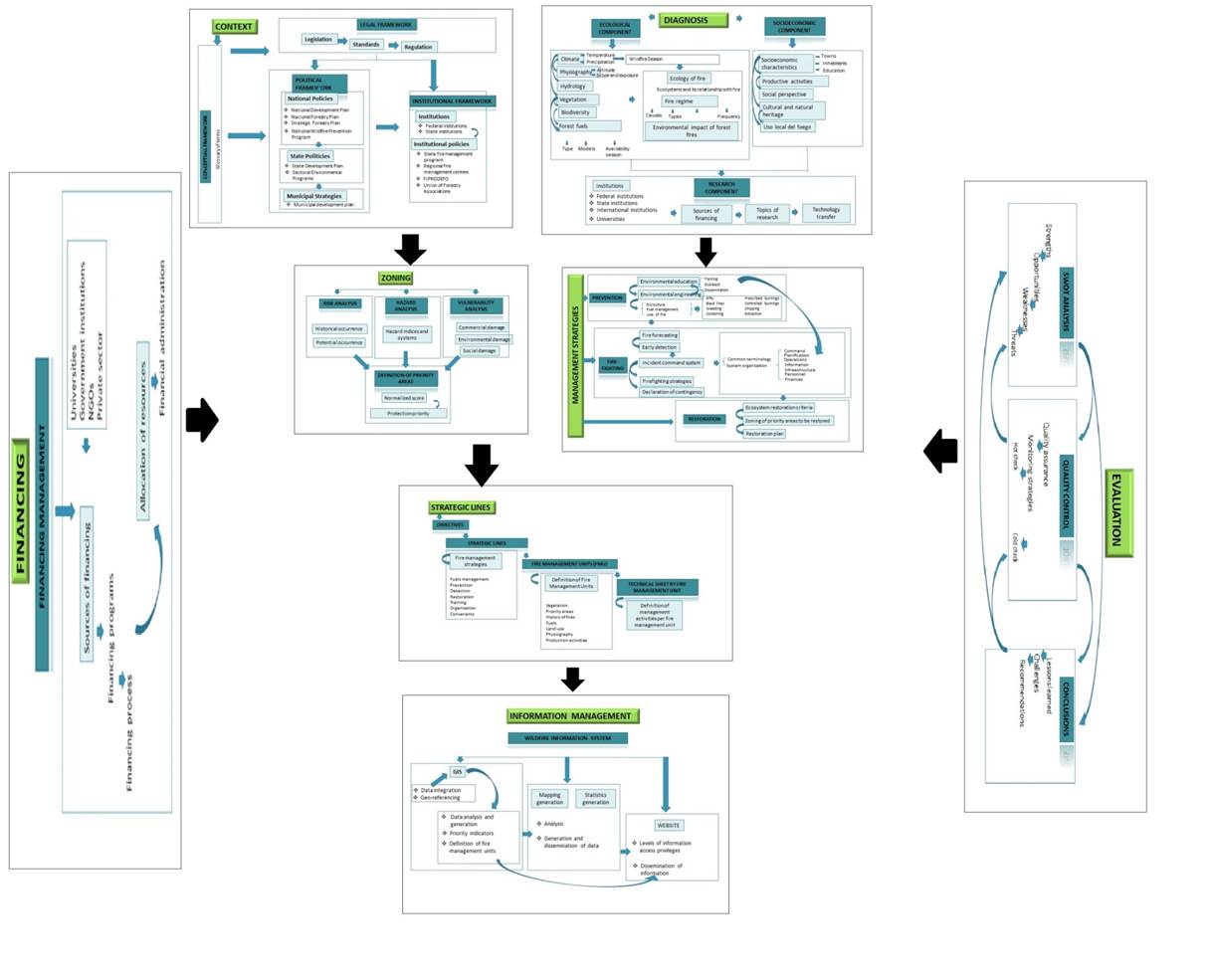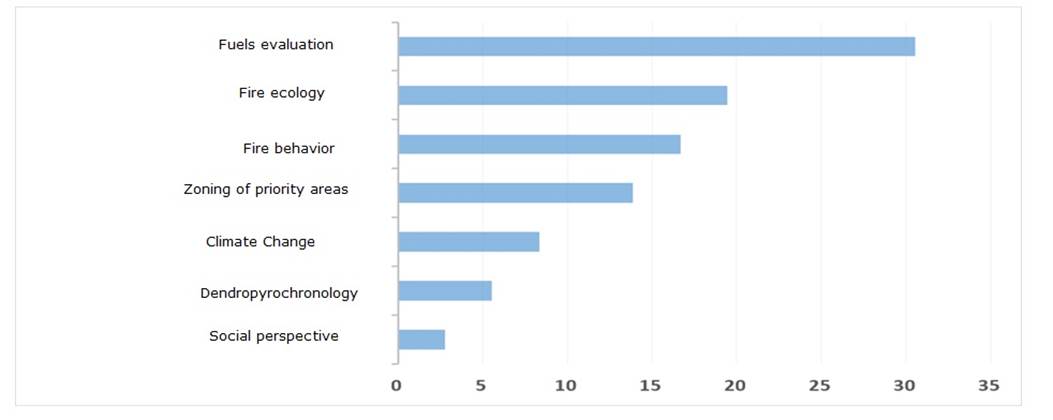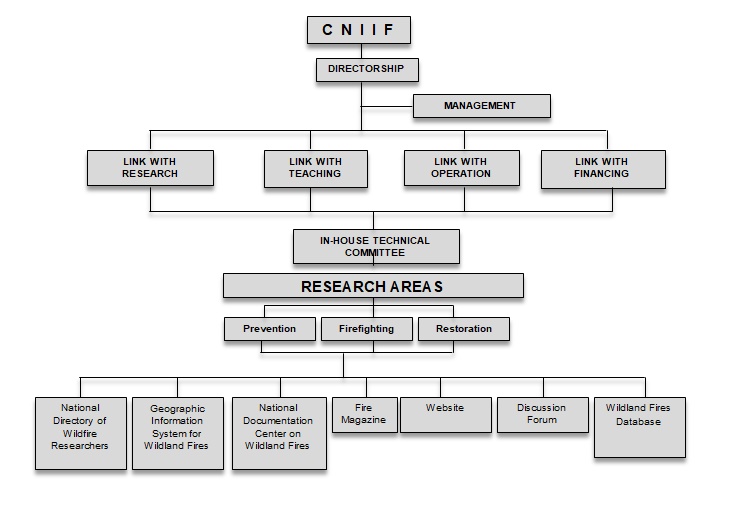Servicios Personalizados
Revista
Articulo
Indicadores
Links relacionados
Compartir
Revista mexicana de ciencias forestales
versión impresa ISSN 2007-1132
Rev. mex. de cienc. forestales vol.12 no.spe1 México nov. 2021 Epub 21-Feb-2022
https://doi.org/10.29298/rmcf.v12iespecial-1.981
Review article
Retrospective and perspectives of forest fire research at INIFAP
1Instituto Nacional de Investigaciones Forestales, Agrícolas y Pecuarias, Campo Experimental Centro Altos de Jalisco. México.
El Instituto Nacional de Investigaciones Forestales, Agrícolas y Pecuarias, INIFAP) (National Institute for Research on Forests, Agriculture and Livestock) has carried out research on forest fires from the perspective of its management. Based on this, work has been done on the following lines: fuel evaluation, fire ecology, fire behavior, zoning, climate change, dendropyrochronology and social perspective. Herein is described a research perspective that proposes organizational strategies, human resources training, and technology transfer, aiming primarily to reconcile the study of fire behavior with a deep ecological analysis of its effects, for which purpose a broader participation of interdisciplinary groups is required. Within this process, INIFAP has supported the training of human resources, by the following strategies: 1) teaching of specific courses on several topics; 2) execution of practical workshops, at both the field and the theoretical levels; 3) support for thesis students at various levels, and 4) integration of working groups in different research projects. It is concluded that INIFAP has contributed to the development of research on forest fires; however, there is still much to do on the subject, such as completing a frame of reference on the problem of forest fires in Mexico, based on which the priority issues are to be determined.
Keywords: Climate change; fire behavior; dendropyrochronology; fire ecology; forest fires; fire management
En el Instituto Nacional de Investigaciones Forestales, Agrícolas y Pecuarias (INIFAP) se ha realizado investigación en incendios forestales orientada desde la perspectiva del concepto de manejo del fuego. Con base en esto, se han desarrollado las siguientes líneas de investigación: evaluación de combustibles, ecología del fuego, comportamiento del fuego, zonificación, cambio climático, dendropirocronología y perspectiva social. Se presenta una perspectiva de investigación, en la cual se proponen estrategias de organización, formación de recursos humanos y transferencia de tecnología. Se plantea conciliar, principalmente, el estudio del comportamiento del fuego con un análisis ecológico amplio de sus efectos, lo que requerirá una participación más diversa de grupos interdisciplinarios. En este proceso, el INIFAP ha apoyado la formación de recursos humanos, que se lleva a cabo con base en las siguientes estrategias: 1) impartición de cursos específicos sobre diversos temas; 2) ejecución de talleres prácticos, tanto a nivel de campo como teórico; 3) apoyo a tesistas de diferentes niveles; y 4) integración de grupos de trabajos en diversos proyectos de investigación. Se concluye que en el INIFAP se ha contribuido al desarrollo de la investigación sobre incendios forestales; sin embargo, aún hay mucho que hacer sobre el tema, como completar un marco de referencia de la problemática de los incendios forestales en México, que constituya la base para la definición de los temas prioritarios por estudiar.
Palabras clave: Cambio climático; comportamiento del fuego; dendropirocronología; ecología del fuego; incendios forestales; manejo del fuego
Introduction
Fires are events which, in one way or another, are part of forest ecosystems. They are also a complex phenomenon, as they can cause a series of short-, medium- and long-term impacts on various aspects (ecological, social, political and economic). In this regard, forest fire research in Mexico has made remarkable achievements in recent years, and a better direction has been determined; however, it has not followed the same rhythm as in other forest disciplines, which may be due to the fact that the number of researchers related to this discipline is still small.
Nevertheless, the role of the National Institute for Research on Forests, Agriculture and Livestock (INIFAP) has been very important, as, since 1984, it has carried out a series of studies related to several topics on forest fires. This has been made possible by the presence at the Institute of researchers, most of them with postgraduate studies, who have joined efforts and experiences with some institutions in Mexico and abroad.
Accordingly, this paper provides a retrospective analysis (1984-2020) of the main achievements generated at INIFAP in the field of forest fire research. This has resulted in an important body of knowledge that several institutions have used in decision making to determine strategies for the prevention, detection and fighting of wildland fires. In addition, a proposal is made as to what could be, in perspective, the orientation for research on this topic at INIFAP.
Fire management perspective
Forest fires involve a variety of factors, such as vegetation, fuels, climate, topography, etc. Therefore, studies conducted at INIFAP take into account the interrelationships between these elements. In this regard, and from the perspective of fire management, research at the Institute is oriented mainly towards the following aspects (Figure 1): a) Context. The standardization of criteria to understand the utilized terminology is supported; b) Diagnosis. The condition of the areas under study must be known from the ecology to the economic and socio-cultural situation; c) Definition of priority areas. Standardized processes have been developed for the appropriate selection of areas that require greater attention and in which research resources should be prioritized; d) Fire management perspective.
The use of fire is closely related to agricultural practices; therefore, different fire management strategies have been considered, including total suppression measures and forest fuels management; e) Information management. In order to run the research properly, INIFAP has compiled, organized and analyzed a large amount of information related to the topic of forest fires; f) Strategic lines. Fire management units, representing areas where similar strategies or lines of action for research can be applied, are determined; g) Financing. Potential sources of financing for the execution of the actions described above are considered; h) Quality control. Ensuring the quality of both the research planning and the actions that integrate the proposed strategic lines requires the implementation of a strict monitoring process to support quality control; and i) Sources of information. In order to support all the studies, information from all available sources must be compiled and ordered, so that it will be accessible for later consultation.
Priority lines of research
Specifically at INIFAP, most of the research work has focused on the evaluation and characterization of forest fuels, fire ecology, and fire behavior estimation (Figure 2). There are few studies on other topics, such as the effects of fire on hydrology and the social evaluation of the actors involved in the problem of forest fires. On the other hand, studies have been carried out on their relationship with climate change, particularly in terms of assessing the potential for carbon emissions when fuels are burned in forests. Figure 2 shows the main lines of research developed at INIFAP, followed by a description of some examples of the work carried out.
Fire ecology
In Mexico, prior to the year 2000, practically no fire was used through prescribed burns, since little was known about the effects of fire on forest ecosystems. Thus, INIFAP evaluated the effect of fire on the soil; for this purpose, different types of prescribed burnings were applied (Flores and Benavides, 1996). The results show a slight (not significant) decrease in the levels of potassium, phosphorus and nitrogen, as well as a (significant) increase in the calcium content. Also, the effect of fire on regeneration was studied by implementing prescribed burns; and it was concluded that a) it is feasible to carry out prescribed burnings, both backward and downslope; b) the establishment of regeneration is favored (Figure 3); c) the intensity of the fire does not affect regeneration enhancement (Flores, 2012). Thus, the spatial relationship between the presence of forest fuels and the establishment of regeneration has been modeled (Flores and Moreno, 2005).
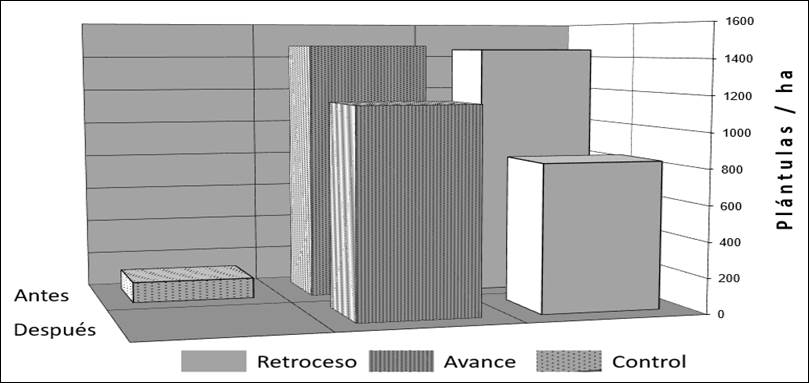
Source: Flores and Moreno (2005)Antes = Before; Retroceso = Regression; Avance = Progress; Control = Control; Plántulas = Seedlings.
Figure 3 Regeneration response to the implementation of prescribed burns.
As for the effect of fire on the dynamics of plant populations, its impact on the structure, diversity and density of forest ecosystems has been studied (Villanueva and McPherson, 2004), specifically, through a comparative analysis of the vegetation between burned and unburned areas. An example is the work developed for an area covered by microphytic desert species (Flores, 2018), where the results suggest that the structure and density conditions of vegetation between burned and unburned areas are not statistically different. However, it is important to point out that these results apply to the site and conditions analyzed and that they are not extensive to all microphyllous shrublands, since in regions where the dry season is more intense, the vegetation does not recover from the impact of fire in the same way.
Work has also been carried out to assess the severity of a forest fire and its impact on understory vegetation (shrubs, herbs, grasses) in temperate forests; based on the analysis of the information generated, it can be said that the relative abundance of the different forms of life varies in relation to the severity of the fire. Herbaceous plants, in general, benefit from intermediate severities, while shrubs and especially grasses are reduced (Cadena et al., 2020). It is concluded that intermediate fire severity provokes a higher abundance of herbaceous plants (Figure 4). On the other hand, the effect of the severity of forest fires has been evaluated through the exploratory analysis of the spatial distribution of trees, which has shown that, as fire severity increases, the spatial distribution of trees tends to aggregate and form dimensionally heterogeneous stands, while the species composition is not affected (Ávila-Flores et al., 2014).
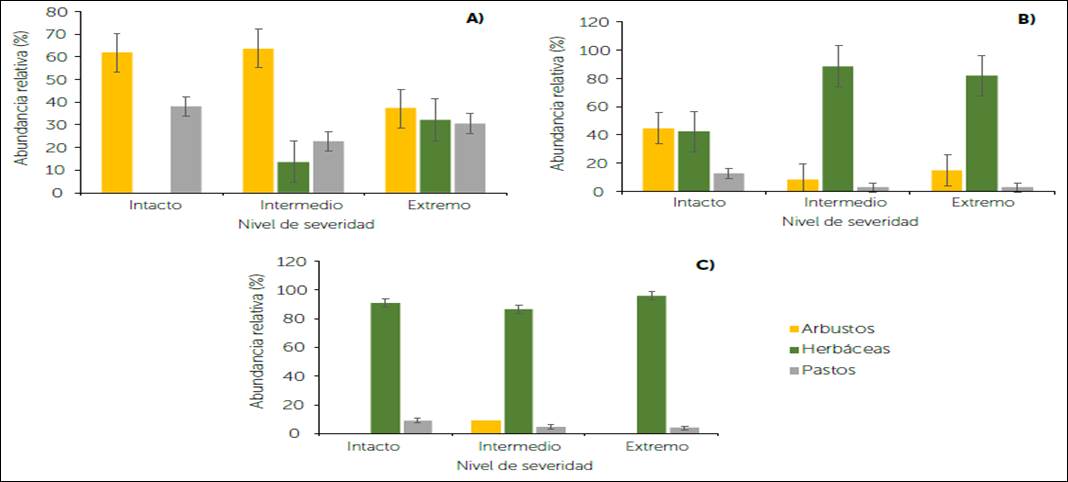
Abundancia relativa = Relative abundance; Nivel de severidad = Severity level; Intacto = Intact; Intermedio = Intermediate; Extremo = Extreme; Arbustos = Shrubs; Herbáceas= Herbs; Pastos = Grasses.
A) La Primavera Forest, Jalisco, Mexico; B) Sierra of Tapalpa, Jalisco, Mexico; C) Sierra de Quila, Jalisco, Mexico (Cadena et al., 2020).
Figure 4 Relative abundance of different life forms (shrubs, herbs and grasses) in relation to fire severity.
Fuel assessment
INIFAP considers that one of the important aspects in the study of forest fires is the evaluation of fuels; therefore, since 1983, the Institute has been a pioneer in the definition of protocols for measuring them (Flores and Benavides, 1996). In general, it analyzes the fuels, distinguishing between the biomass and the necromass (Rubio et al., 2016), following two courses of action:
1) Direct determination, by means of specific field inventories (Rentería et al., 2005; Chávez et al., 2016). Studies in which spatial interpolation techniques have been tested to generate forest fuel maps with the highest possible accuracy (Flores and Omi, 2003).
2) Development of indirect estimation strategies such as photoseries and satellite imaging (Flores and Moreno, 2005).
In this regard, the study of forest ecosystems is considered to involve the evaluation of large areas, which affects both time and costs; therefore, alternatives that guarantee practical procedures with scientific support are contemplated. Likewise, the role of forest fuels in the establishment and development of tree regeneration has been studied, specifically as to their spatial relationship, using geostatistical strategies (Flores and Moreno, 2005).
Although the behavior of forest fires can be simulated through a variety of systems (e.g.: Farsite, Behave and Prometheus), these require fuel model maps. Thus, INIFAP carried out one of the first attempts to classify a forest region into fuel model classes with the use of Geographic Information Systems, remote sensing, Global Positioning System (GPS) and geostatistics. For this purpose, the concept of Fuel Proportion Factor (Table 1) was defined in order to classify sampled sites within certain fuel models (Flores and Omi, 2003; Flores et al., 2005; Flores, 2017a). Several forest fuel sampling strategies have also been tested, such as simple random sampling (SRS <MSA>) and stratified random sampling (StrRS <MAE>); whose results indicate that StrRS is 674, 276 and 360 % more accurate than SRS for a one-hour delay (1HR), litter and organic matter (OM) fuels, respectively (Flores et al., 2005).
Table 1 Fuel loads (t ha-1) of fuel complexes (Anderson, 1982, cited by Flores and Omi, 2003) and the corresponding Fuel Proportioning Factor (FPF) value.
| Model | Fuel complexes | 1-h | 10-h | 100-h | FPF |
|---|---|---|---|---|---|
| FM-8 | Remains of timber harvesting | 3.36 | 2.24 | 5.60 | < 3.25 |
| FM-9 | Remains of hardwoods | 6.55 | 0.92 | 0.34 | 3.25 - 5.11 |
| FM-10 | Timber (debris and undergrowth) | 6.75 | 4.88 | 11.23 | >5.11 |
Adapted from Flores and Omi (2003).
FM-8= Fuel model 8; FM-9= Fuel model 9; FM10= Fuel model 10.
Given that fire behavior simulation systems use mathematical models based on fuel moisture, among other factors, INIFAP has proposed procedures to calculate this (Flores and Gómez, 2011), and, therefore, to strengthen the methodologies and techniques used for its estimation, as it defines the onset and spread of a forest fire.
In the research on forest fuels, photoseries are an option that has been little used in Mexico; therefore, the Institute has carried out comparative analyses of the spatial distribution of fuel loads using the following methods: a) the direct assessment of fuels; and b) photoseries (Flores and Moreno, 2005). In general, the direct assessment of the spatial distribution of fuels proved better than the use of photoseries. Work has also been done to standardize the processes for the study of forest fuels, allowing the results to be comparable and compatible. For this purpose, tools have been developed to estimate the quantity of fuel, such as the Forest Fuels Assessment System (FFAS) (Chávez et al., 2017).
Climate change
Since the occurrence of the 1998 fires in Mexico, interest in the influence of fire on environmental pollution has increased considerably. Although very important work has been developed in this regard in the country (Cruz-López et al., 2019), it is still necessary to model the influence of the spatial variation of fuel types and loads. For this purpose, an analysis is made of the evaluation processes of the topsoil (T) and fallen woody material (fWM) loads, in which the corresponding carbon (C) contents cited in Mexico are specified (Flores-Garnica et al., 2018). In addition, standard protocols have been proposed to ensure that the information generated is comparable and compatible.
On the other hand, strategies have been developed to estimate the amount of greenhouse gas emissions (carbon dioxide ENT#091;CO2ENT#093;, methane ENT#091;CH4ENT#093; and carbon monoxide ENT#091;COENT#093;) that are released in the event of a forest fire. These are based on the direct measurement of fuel loads, which in turn serve as the basis for determining the spatial variations of greenhouse gas emissions in relation to fuel beds (Figure 5) (Flores and Gottfried, 2018).
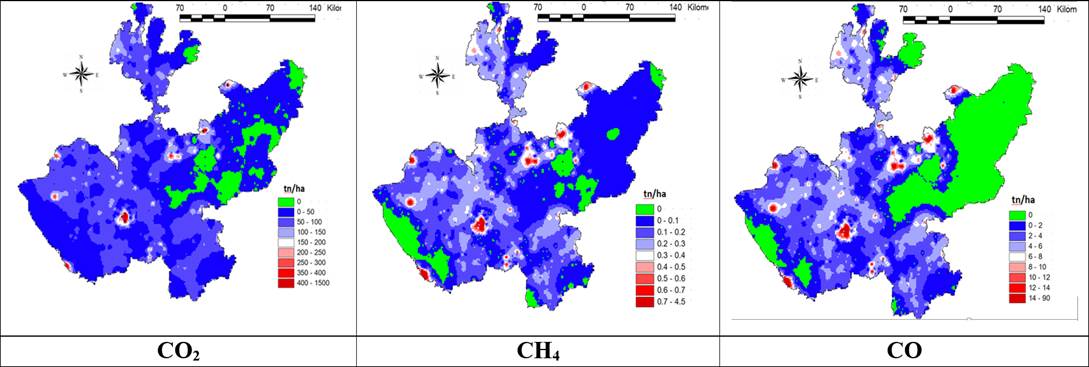
Source: Flores and Gottfried (2018).
Figure 5 Spatial variation of potential emissions of CO2, CH4 and CO from the burning of fuel beds in forest ecosystems in the state of Jalisco.
Fire behavior
The use of prescribed burnings in Mexico is restricted, mainly because little is known about the behavior of fire under forest conditions. Therefore, this has been a topic of study at INIFAP, through the development of fire behavior simulation models that use data obtained from forest inventories, such as the distribution of fuels. This information supports supervised and unsupervised classifications of satellite imagery (Figure 6), resulting in accuracy levels (74.9 %) adequate to support simulations of fire behavior in prescribed burns; and thus determine, initially, the size, shape and geographic location of the spread of a fire (Flores and Omi, 2003).
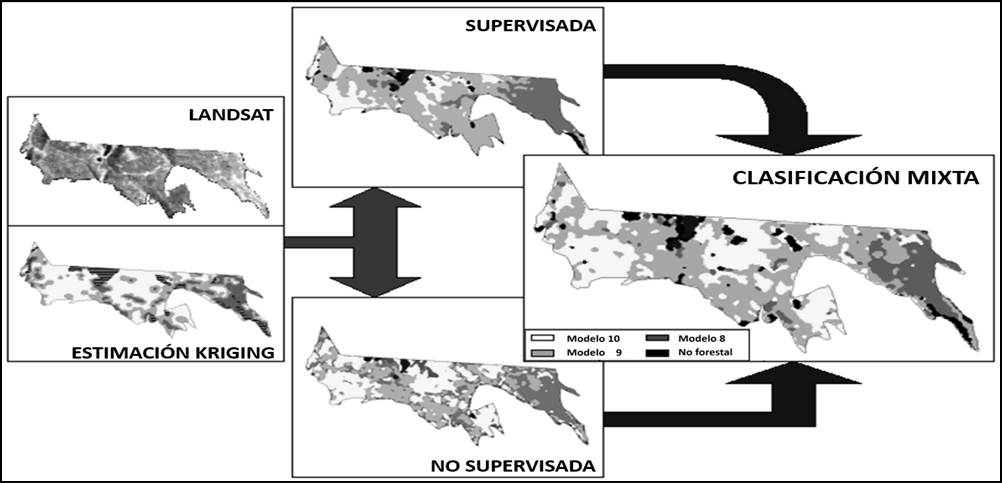
Estimación Kriging = Kriging estimate; Supervisada = Supervised; No supervisada = Unsupervised; Clasificación mixta = Mixed Classification
Source: adapted from Flores and Omi (2003).
Figure 6 General process for defining supervised, unsupervised and mixed classifications supported by Kriging estimates.
This type of research has generated thematic maps (raster format) that support simulation models of spatial changes in fire dispersion (Flores et al., 2005). These models describe the modifications in the spatial pattern of fire spread from an initial time (t) to a given period (t + tn), which are a function of the specified time and the deterministically simulated rate of spread (Figure 7). The raster perspective facilitates the scheduling process, as it helps to understand why the fire spreads in a certain direction.
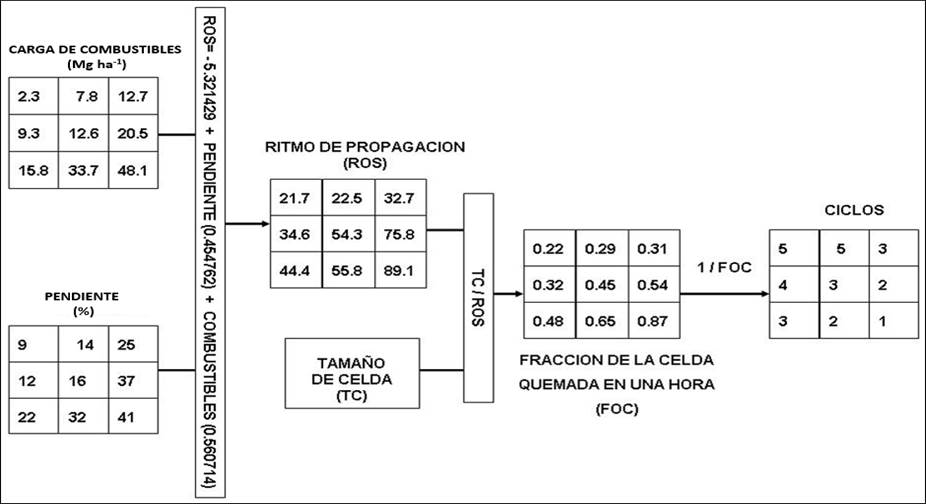
Source: Flores et al. (2005).
Pendiente = Slope; Carga de combustibles = Fuel charge; Ritmo de propagación = Rate of spread; Tamaño de la celda = Cella size; Fracción de la celda quemada en una hora = Fraction of cell burned in one hour; Ciclos = Cycles.
Figure 7 Algorithm defining the number of cycles (hours required) to completely burn out a cell.
As a validation strategy, INIFAP has carried out evaluations of fire behavior directly in the field under different environmental conditions: pine, pine-oak, holm oak, shrubs and grasslands (Flores et al., 2006); in which records were obtained of: a) environmental conditions, such as wind speed (m min-1), fuel loads (Mg ha-1), relative humidity (%) and temperature (Co); and b) fire behavior: fire propagation speed (m min-1), flame height (m), flame length (m) and heat per unit area (Btu (m2)-1). In this way, it is possible to estimate, with some precision, whether fire in a forest fire or prescribed burn has a moderate behavior, and whether it is feasible to use it in a controlled manner to achieve specific objectives. In this context, work was carried out at the Institute to monitor the influence of environmental factors on fire behavior (Figure 8), under the implementation of prescribed burns, mainly in temperate ecosystems (pine-oak) (Flores et al., 2010).
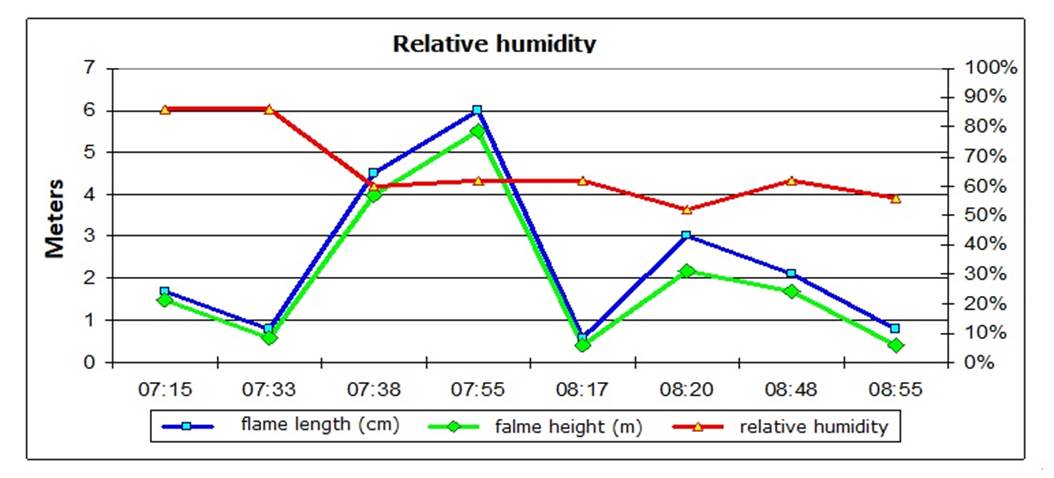
Source: Flores et al. (2010).
Figure 8 Variations in fire behavior in relation to changes in relative humidity.
Zoning of priority areas
One of the most important demands of the operational areas working on forest fires is the technological tools that allow them to locate and size priority areas of attention. This is due to common constraints in terms of availability of financial, human, equipment, infrastructure and time resources; in response to this requirement, INIFAP has carried out research work related to the classification and location of areas according to their fire risk (Martínez et al., 1990) and spatially associated factors that favor it (Ávila-Flores et al., 2010b). For this purpose, one of the first fire danger indexes on the Internet was implemented in Mexico, which was designed based on a dynamic geographic information system (Sepúlveda et al., 1999). Eventually, researchers from the Institute have collaborated in the development of similar systems (Muñoz et al., 2005; Velasco et al., 2013) that support the location and sizing of priority areas classified in different risk levels; for example: null, low, moderate and high.
In addition, specific cartography has been developed on priority areas for protection against forest fires, which are defined according to criteria such as risk and severity. In this way, the area burned is used as a criterion for determining priority areas (Figure 9). However, it is considered that these processes should be standardized; therefore, among other aspects, it has been necessary to establish a common sampling unit to obtain comparable and compatible information. In this regard, INIFAP has conducted studies aimed at determining a sampling unit size to capture the spatial variability of the area burned by forest fires (Flores, 2017b).
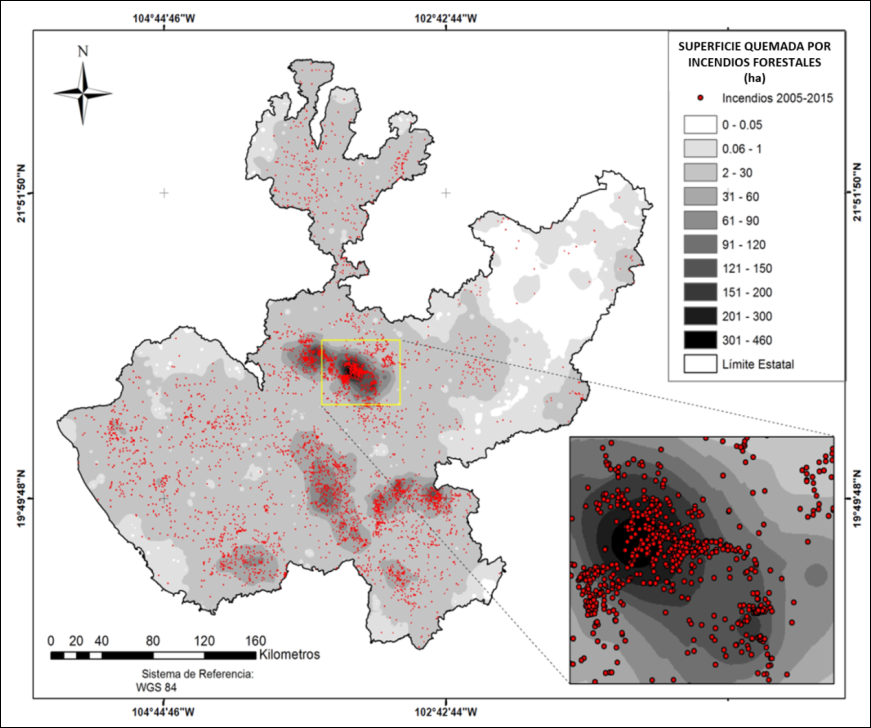
Source: Flores (2017b).
Figure 9 Spatial distribution of the average area (ha) burned by forest fires, with an area of 100 km2 in Jalisco.
Research has also been implemented to prioritize areas in relation to the greatest number of fires per unit area (density), which has allowed the corresponding mapping to be generated by using alternative strategies such as Kernel density estimation, which requires the selection of a function and an appropriate bandwidth (h) (Flores-Garnica and Macías-Muro, 2018). On the other hand, exploratory analyses of the spatial distribution pattern of forest fires have been carried out, under the hypothesis that fires present a non-random spatial pattern, and the results show a high spatial autocorrelation (Ávila-Flores et al., 2010a).
Dendropyrochronology
Using dendrochronology techniques, specifically those focused on detecting forest fires (dendropirochronology) based on fire scars, INIFAP has defined fire regimes in several forest ecosystems in Mexico (Ávila-Flores et al., 2014); which confirm the association between the presence of droughts and the occurrence of fires with <ENSO> events (Cerano et al., 2010; Cerano-Paredes et al., 2015; Cerano-Paredes et al., 2016). Within this context, it is important to highlight the establishment in Mexico of the first dendrochronology laboratory: INIFAP's National Dendrochronology Laboratory, where an important group of people interested in the subject has been trained (Villanueva et al., 2011) and has generated a richness of important knowledge on the subject, among which the following stand out: a) diverse tree-ring chronologies, distributed in a network of dendrochronological time series to quantify the influence of circulatory patterns affecting central and northern Mexico; b) historical reconstructions of rainfall and water flows; c) location of ancient trees for conservation purposes (Constante et al., 2009; Villanueva et al., 2015). This information is essential for better planning of water resources, conservation and sustainable use of forest ecosystems (Villanueva et al., 2015).
Social approach
As almost all forest fires in Mexico are caused by arson and have their origin mainly in anthropogenic activities (Flores and Flores, 2018). This implies that, on average, only about 2 % of fires are caused by natural factors. In this regard, INIFAP considers analyzing the social perspective of the problem of forest fires, which is done through surveys directed to some federal, state, municipal and non-governmental institutions (Flores and Flores, 2018), which consisted of a series of multiple-choice questions focused on various aspects of the use of fire in agricultural and forest activities (Figure 10). It is rarely reported when a burn gets out of control.
Research perspectives
Based on what has been presented in the previous sections, it is considered that the planning of research on forest fires at INIFAP should promote the participation of interdisciplinary groups; the above, in order to have a greater capacity to face the complexity of the study of these events. To this end, it must be taken into account that fire affects several elements of forest ecosystems (water, vegetation, fauna, air, soil, etc.). For this reason, it is necessary to combine the efforts of specialists from different disciplines in order to avoid common mistakes such as carrying out studies with a high focus on fire behavior and little ecological analysis, or carrying out studies with a high ecological analysis, but without any idea of fire behavior.
Accordingly, although there are many contributions on the subject, it is still necessary to follow a process of prioritization of research needs based on a national work plan. Likewise, through the inclusion of new researchers, we seek to address areas that lack studies, such as hydrology, restoration, the effect of retardants, among others.
From this perspective, the aim is to guide the priorities in terms of training INIFAP researchers in three types of research proposals ―1) prevention; 2) fighting, and 3) restoration―, and to direct research to the following aspects: prescribed burning, fire behavior, fuels assessment, global warming, climatology, fire ecology, fire retardants, equipment and tools, risk, severity, combustibility, fauna, soil, vegetation, dendropirochronology, human health, insects and pollution, among others.
Research organization
The attention to the problem of forest fires involves the study of diverse topics; therefore, and in order to ensure the efficient use of resources at INIFAP, it is necessary to avoid duplication of projects and the lack of coordination in terms of publishing publications on the subject. In addition, a good orientation of human resources training must be considered, since there are many areas to be strengthened and several in which there is no researcher. Inter-institutional coordination should also be encouraged to support the formation of a National Wildfire Research Center (Figure 14), which would have, among others, the following functions: 1) to promote and coordinate the participation of different institutions; 2) creation and administration of the National Directory of Forest Fire Researchers; 3) collection, management and dissemination of forest fire documentation; 4) support in human resources training; 5) obtain and manage financial support; 6) provide support in human resources training; 6) guide and suggest research topics; 7) disseminate results through a National Wildfire Documentation Center (Cedif); 8) organization of conferences; 9) support the exchange of experts from other countries; 10) group and manage databases; 11) linking research activities to operational activities; 12) edit and manage a technical-operational journal (Fire Magazine).
Training of human resources
INIFAP supports the training of human resources, both internally and in other institutions, which is carried out on the basis of the following strategies: 1) specific courses and workshops on various topics, aimed at firefighters, civil servants, researchers, and students, which are organized in collaboration with the National Forest Commission (Conafor, for its acronym in Spanish), Comisión Nacional de Áreas Naturales Protegidas, Conanp (National Commission of Natural Protected Areas), foresters and universities; 2) execution of practical workshops, both in the field and in theory; 3) support to thesis students at different levels, and 4) integration of work groups in several research projects. In addition, extensive documentation has been generated that can be used to support the training of human resources.
The provision of training requires the growth and development of infrastructure and equipment such as laboratories, experimental fields, offices, library, vehicles, tools, measuring equipment, among others.
Technology transfer
In general, one of the purposes of research at INIFAP is the generation of technologies that support operational activities related to the production and conservation of forest resources. In this context, it will continue to capture the needs of the operating sector, which could be solved through research, so that the thematic defined should have a direct link with the users. This would guarantee support for the technology transfer process and, in turn, reinforce the basic research that backs it up.
This implies ensuring that the technology transfer process is completed in all its stages; i.e., from the generation of new wildfire management technology to its adoption by fire management decision makers. In addition, during the technology transfer, it will be possible to determine the research priorities on forest fires that should be addressed at INIFAP, which will have to take into account national and international policies, as well as state and municipal requirements on the matter.
Conclusions
The Instituto Nacional de Investigaciones Forestales, Agrícolas y Pecuarias, together with a few other institutions, has made relevant contributions to the development of forest fire research in Mexico. However, there is still much to be done on the subject. Firstly, there should be a frame of reference for the forest fire problem that includes a diagnosis of what is known in Mexico, based on which not only priority issues are defined, but also those regions that require an immediate response. In addition, short-term, medium-term and long-term goals must be established; to this end, existing capacities must be identified, as well as the potential that can be generated.
In regard to the latter, it is suggested to continue with the training plan at various levels that is currently being carried out, within the framework of which scientists are prepared in priority areas and in areas in which there are no specialists. This is related to continue the training of human resources through thesis students or collaborators, and the execution of courses and workshops. It is also required to strengthen the technology transfer process, without neglecting the balance between the development of basic science and applied science; in such a way that efforts are oriented towards the generation of knowledge and technologies that can be operationally applied.
On the other hand, it will be necessary to support and promote inter-institutional collaboration, focused on the development of research that involves not only ecological aspects, but also social and economic aspects that consider the particularities of Mexico's diverse forest ecosystems.
Referencias
Ávila-Flores, D. Y., M. Pompa-García y E. Vargas-Pérez. 2010a. Análisis espacial de la ocurrencia de incendios forestales en el estado de Durango. Revista Chapingo Serie Ciencias Forestales y del Ambiente 16(2): 253-260. Doi: https://doi.org/10.5154/r.rchscfa.2009.08.028. [ Links ]
Ávila-Flores, D., M. Pompa-García, X. Antonio-Nemiga, D. A. Rodríguez-Trejo, E. Vargas-Pérez y J. Santillán-Pérez. 2010b. Driving factors for forest fire occurrence in Durango state of Mexico: A geospatial perspective. Chinese Geographical Science 20(6): 491-497. Doi: https://doi.org/10.1007/s11769-010-0437-x. [ Links ]
Ávila F., D.Y., M. A.González T., J. Jiménez P., O. A. Aguirre C., E. J. Treviño G. y B. Vargas L. 2014. Dendrocronopirología: Análisis de la evidencia morfológica de incendios forestales. Nota de Investigación. Revista Mexicana de Ciencias Forestales 5(21): 136-147. Doi: https://doi.org/10.29298/rmcf.v5i21.363. [ Links ]
Ávila-Flores, D.Y., González T., M.A., Jiménez P., J., Aguirre C., O.A., Treviño G., E., Vargas L., B., Alanís R., B. 2014. Efecto de la severidad del fuego en las características de la estructura forestal en rodales de coníferas. Revista Chapingo Serie Ciencias Forestales y del Ambiente 20(1):33-45. Doi:https://doi.org/10.5154/r.rchscfa.2013.01.005. [ Links ]
Cadena Z., D. A., J. G. Flores-Garnica, A. G. Flores-Rodríguez y M. E. Lomelí-Zavala. 2020. Efecto de incendios en la vegetación de sotobosque y propiedades químicas de suelo de bosques templados. Agroproductividad 13(4): 65-72. Doi:https://doi.org/10.32854/agrop.vi.1684. [ Links ]
Cerano P., J., J. Villanueva D. y P. Z. Fulé. 2010. Reconstrucción de incendios y su relación con el clima para la Reserva Cerro El Mohinora, Chihuahua. Revista Mexicana de Ciencias Forestales 1(1): 63-74. Doi: https://doi.org/10.29298/rmcf.v1i1.654. [ Links ]
Cerano-Paredes, C., J. Villanueva-Díaz, R. Cervantes-Martínez, P. Fulé, L. Yocom, G. Esquivel-Arriaga y E. Jardel-Peláez. 2015. Historia de incendios en un bosque de pino de la sierra de Manantlán, Jalisco, México. BOSQUE 36(1): 41-52. Doi:http://dx.doi.org/10.4067/S0717-92002015000100005. [ Links ]
Cerano-Paredes, J., J. Villanueva-Díaz, L. Vázquez-Selem, R. Cervantes-Martínez, G. Esquivel-Arriaga, V. Guerra-de la Cruz Z y P. Z. Fulé. 2016. Régimen histórico de incendios y su relación con el clima en un bosque de Pinus hartwegii al norte del estado de Puebla, México. BOSQUE 37(2): 389-399. Doi: http://dx.doi.org/10.4067/S0717-92002016000200017. [ Links ]
Chávez D., A. A., J. Xelhuantzi C., E. A. Rubio C., J. Villanueva D., H. E. Flores L. y C. de la Mora O. 2016. Caracterización de cargas de combustibles forestales para el manejo de reservorios de carbono y la contribución al cambio climático. Revista Mexicana de Ciencias Agrícolas 13(2016): 2589-2600. Doi:https://doi.org/10.29312/remexca.v0i13.485. [ Links ]
Chávez D., A.A., J. Xelhuantzi C., E. A. Rubio C., J. Villanueva D. y J. G. Flores G. 2017. Actualización del sistema para el cálculo de combustibles forestales (SICCO v3.0). Revista Mexicana de Ciencias Forestales 8(44): 158-178. Doi:https://doi.org/10.29298/rmcf.v8i44.109. [ Links ]
Constante G., C., J. Villanueva D., J., Cerano P., E. H. Cornejo O. y S. Valencia M. 2009. Dendrocronología de Pinus cembroides Zucc. y reconstrucción de precipitación estacional para el Sureste de Coahuila. Revista Ciencia Forestal en México 34(106): 17-39. http://www.scielo.org.mx/scielo.php?script=sci_arttext&pid=S1405-35862009000200002 (15 de agosto de 2020). [ Links ]
Cruz-López, M. I., L. L. Manzano-Delgado, R. Aguirre-Gómez, E. Chuvieco y J. A. Equihua-Benítez. 2019. Spatial distribution of forest fire emissions: A case study in three mexican ecoregions. Remote Sensing 11(10): 1185. Doi: https://doi.org/10.3390/rs11101185. [ Links ]
Flores G., J. G. and J. D. Benavides S. 1996. Soil chemical changes due to fire when prescribed burns are applied in a temperate forest of Mexico. Revista Internacional de Contaminación Ambiental 12 (2): 75-81. https://www.redalyc.org/articulo.oa?id=37012204 (1 de agosto de 2020). [ Links ]
Flores G., J. G. and P. N. Omi. 2003. Mapping forest fuels for spatial fire behavior simulations using geomatic strategies. Agrociencia 37: 65-72. https://www.colpos.mx/agrocien/Bimestral/2003/ene-feb/art-7.pdf (9 de julio de 2020). [ Links ]
Flores G., J. G., D. A. Moreno G. y J. D. Benavides S. 2005. Simulación espacial de dispersión del fuego en función de la carga de combustible y pendiente. Revista Ciencia Forestal en México 30(97): 7-27. https://cienciasforestales.inifap. gob.mx/editorial/index.php/forestales/article/view/865 (3 de junio de 2020). [ Links ]
Flores G., J. G. y D. A. Moreno G. 2005. Modelaje espacial de la influencia de combustibles forestales sobre la regeneración natural de un bosque perturbado. Agrociencia 39(3): 339-349. https://www.redalyc.org/articulo.oa?id=30239311 (12 de junio de 2020). [ Links ]
Flores G., J. G., A. Rosas V. y D. A. Moreno G., D. A. 2005. Limitaciones espaciales de los modelos de combustibles forestales al comparar dos diseños de muestreo. Ciencia Forestal en México 28(93): 57-77. http://cienciasforestales.inifap.gob.mx/editorial/index.php/Forestales/article/view/890 (24 de junio de 2020). [ Links ]
Flores G., J. G., D. A. Moreno G. and J. D. Benavides S. 2006. Forest fire behaviour in prescribed burns under different environmental conditions in Mexico. Forest Ecology and Management. 234S(2006) S131. DOI: https://doi.org/10.1016/j.foreco.2006.08.172. [ Links ]
Flores G., J. G., J. Xelhuantzi C. y A. A. Chávez D. 2010. Monitoreo del comportamiento del fuego en una quema controlada en un rodal de pino-encino. Revista Chapingo. Serie Ciencias Forestales y del Ambiente 16(1): 49-59. Doi: https://doi.org/10.5154/r.rchscfa.2009.05.017. [ Links ]
Flores G., J. G. y L. P. Gómez M. 2011. Estimación práctica de la variabilidad de la humedad de combustibles bajo diferentes ecosistemas forestales. Revista Mexicana de Ciencias Forestales 2(5): 45-58. Doi: https://doi.org/10.29298/rmcf.v2i5.583. [ Links ]
Flores G., J. G. 2012. Analysis of pseudoreplicants to evaluate natural regeneration after applying prescribed burns in a temperate forest of Mexico. Open Journal of Forestry 2(1): 9-16. Doi: https://doi.org/10.4236/ojf.2012.21002. [ Links ]
Flores G., J. G. 2017. Spatial distribution of fuel models based on the Conditional-Fuel-Loading concept. Journal of Environmental Protection 9(2): 111-121. Doi: 10.4236/jep.2018.92009. [ Links ]
Flores G., J.G. 2017. Unidad de muestreo para determinar la variabilidad espacial de la superficie quemada por incendios forestales. Revista Mexicana de Ciencias Forestales , 8(43): 117-142. Doi:https://doi.org/10.29298/rmcf.v8i43.68. [ Links ]
Flores-Garnica, J. G., J. C. Wong-González y F. Paz-Pellat. 2018. Camas de combustibles forestales y carbono en México. Madera y Bosques 24: 1-15. Doi:https://doi.org/10.21829/myb.2018.2401893. [ Links ]
Flores G., J. G. 2018. Structure and density analysis of a semi desert ecosystem disturbed by fire. Open Journal of Forestry 8(2): 155-166. Doi: https://doi.org/10.4236/ojf.2018.82011. [ Links ]
Flores G., J. G. and A. G. Flores R. 2018. Perspectiva antropogénica del uso del fuego como apoyo a la mitigación de incendios forestales. Mitigación del Daño Ambiental Agroalimentario y Forestal de México 4(5): 54-65. http://revistamitigacion.com/ (25 de agosto de 2020). [ Links ]
Flores G., J. G. y E. Gottfried B. 2018. Emisiones potenciales de gases efecto invernadero en camas de combustibles forestales. Mitigación del Daño Ambiental Agroalimentario y Forestal de México 4(5): 1-15. http://revistamitigacion.com/ (25 de agosto de 2020). [ Links ]
Flores-Garnica, J. G. and A. Macías-Muro. 2018. Bandwidth selection for kernel density estimation of forest fires. Revista Chapingo Serie Ciencias Forestales y del Ambiente 24(3): 313-327. Doi: https://doi.org/10.5154/r.rchscfa.2017.12.074. [ Links ]
Martínez M., A., J. G. Flores G. y J. D. Benavides S. 1990. Índices de riesgo de incendios en la sierra de Tapalpa, Estado de Jalisco. Revista Ciencia Forestal en México 15 (67): 3-34. [ Links ]
Muñoz R., C. A., E. J. Treviño G., J. Verástegui C, J. Jiménez P. y O. A. Aguirre C. 2005. Desarrollo de un modelo espacial para la evaluación del peligro de incendios forestales en la Sierra Madre Oriental de México. Investigaciones Geográficas 56: 101-117. https://www.redalyc.org/articulo.oa? (15 de junio de 2020). [ Links ]
Rentería A., J. B., E. J. Treviño G., J. J. Návar C., O. A. Aguirre C. e I. Cantú S. 2005. Caracterización de combustibles leñosos en el ejido Pueblo Nuevo, Durango. Revista Chapingo Serie Ciencias Forestales y del Ambiente 11(1): 51-56. https://www.redalyc.org/articulo.oa?id=62911108 (22 de julio de 2020). [ Links ]
Rubio C., E. A., M. A. González T., J. D. Benavides S., A. A. Chávez D. y J. Xelhuantzi C. 2016. Relación entre necromasa, composición de especies leñosas y posibles implicaciones del cambio climático en bosques templados. Revista Mexicana de Ciencias Agrícolas 13: 2601-2614. Doi:https://doi.org/10.29312/remexca.v0i13.486. [ Links ]
Sepúlveda, B. J., C. W. Zúñiga, E. M. Olguín y P. A. Gomero. 1999. Implementación de un sistema de información geográfica para la prevención de incendios forestales en Baja California. INIFAP, SAGAR. La Paz, BCS, México. Folleto Científico No. 1. 21 p. [ Links ]
Velasco H., J. A., J. G. Flores G., B. Márquez A. y S. López. 2013. Áreas de respuesta homogénea para el muestreo de combustibles forestales. Revista Mexicana de Ciencias Forestales 4 (15): 41-53. Doi: https://doi.org/10.29298/rmcf.v4i15.447. [ Links ]
Villanueva D., J. y G. R. McPherson. 2004. Impacto del cambio de uso del suelo e incendios en la estructura de tres comunidades forestales. Revista Ciencia Forestal en México 27(91): 27-53. https://cienciasforestales.inifap.gob.mx/editorial/index.php/forestales/article/view/907 (7 de septiembre de 2020). [ Links ]
Villanueva, J., J. Cerano P., D. W. Stahle, B. H. Luckman, M. D. Therrell, M. K. Cleaveland y P. Z. Fulé. 2011. La dendrocronología y reconstrucciones paleoclimáticas del norte-centro de México. Escenarios de cambio climático, registros del Cuaternario en América Latina. 1era. Edición. Dirección General de Fomento Editorial UNAM. México, D.F., México. pp. 47-72. [ Links ]
Villanueva D., J., J. Cerano P., L. Vázquez S., D. W. Stahle, P. Z. Fulé, L. L. Yocom, O. Franco R. y J. A. Ruiz C. 2015. Red dendrocronológica del pino de altura (Pinus hartwegii Lindl.) para estudios dendroclimáticos en el noreste y centro de México. Investigaciones Geográficas 86: 5-14. https://doi.org/10.14350/rig.42003. [ Links ]
Received: April 21, 2021; Accepted: June 22, 2021











 texto en
texto en 

